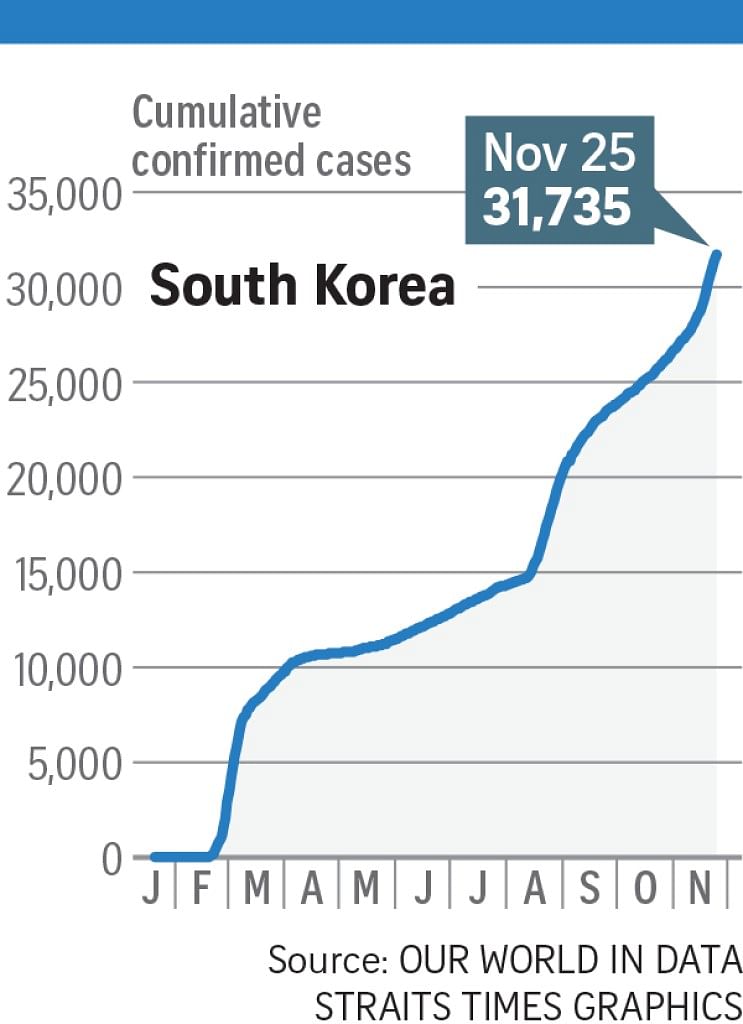Falling temperatures, young asymptomatic spreaders and small social gatherings where people tend to take off their masks are fuelling South Korea's latest surge in coronavirus cases, viewed as the third major wave since February and possibly the toughest to curb.
The country, which has successfully used massive testing and aggressive contact tracing to stem outbreaks without resorting to lockdowns, is now struggling to contain Covid-19 ahead of an all-important college entrance exam due on Dec 3.
What was once the worst-case scenario of 100 cases a day is now the new low benchmark in a five-tier scheme introduced this month to reflect more realistic targets as the fight against Covid-19 stretches into the long haul.
Professor Choi Jae-wook of Korea University's College of Medicine pointed out that the government's response to community infections that started in the June-July period was ineffective to begin with, and that people became tired of social distancing.
"Now, it is impossible to keep the number of confirmed cases at 100 as in the past," he told The Straits Times.
"The quarantine policy should be re-established on the premise there are 400 to 500 confirmed cases, and quarantine and treatment capabilities improved to enable control and management."
The country reported 382 cases yesterday - the highest since August, when gatherings at a church and a public rally triggered the second wave of infections.
This brings the total tally to 31,735, with a death toll of 513.
Each patient currently infects 1.5 people, but experts fear this figure will grow as winter arrives and people are confined in crammed indoor spaces where viruses thrive.
South Korea has relied on mobile phone data, credit card records and closed-circuit television footage to track transmissions. But the new wave presents a challenge as many small clusters are happening in vastly different locations.
Since Tuesday, restrictions on social gatherings have been tightened in Seoul and greater Seoul.
Clubs and bars must close for two weeks, while karaoke rooms and indoor sports facilities are allowed to operate only until 9pm.
The measures are aimed at curbing a growing number of infections from small gatherings in public places that contributed to the current spike.
Experts said people tend to let their guard down and take off their masks at such gatherings, allowing the virus to spread more easily.
The measures also target young people. Patients in their 20s account for about 20 per cent of all infections, up from 10 per cent two months ago and the highest among the various age groups.
Dr Jung Eun-kyeong, chief of the Korea Disease Control and Prevention Agency, said they pose a higher risk of spreading the virus in the community as they often show no or mild symptoms, and continue to lead active social lives.
Easing social distancing measures before the virus situation had stabilised was also a mistake, noted Dr Kim Woo-joo of Korea University Guro Hospital's infectious disease department.
A cluster in a club in May and one in a church in August both emerged after social distancing rules were eased too quickly.
"In the end, the government will just be repeating the same mistakes and continuing a vicious circle," said Dr Kim.
"The lesson learnt is that only countries that took pre-emptive and bold measures suffered minimal damage."













